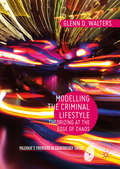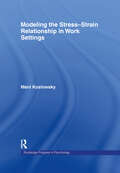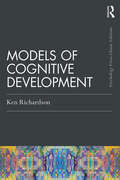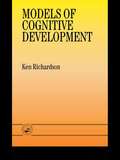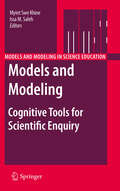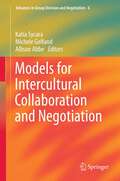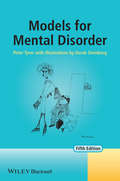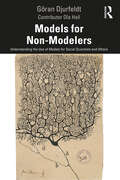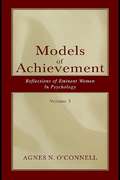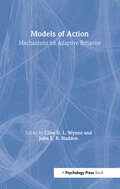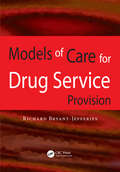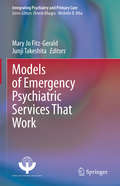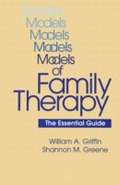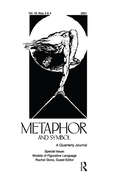- Table View
- List View
Modelling the Criminal Lifestyle
by Glenn D. WaltersThis book offers Walters's latest evolution of criminal lifestyle theory. It introduces the concept of criminal thought content to illustrate how the potential interplay between what offenders think and their thought processes can greatly aid our understanding of both crime and criminals. In this new study on criminal behaviour, Walters calls for criminological theory to be placed within a broader scientific context, and provides us with several key models which embrace constructs from numerous important theories including: the general theory of crime, social cognitive and social learning theories, general strain theory, psychopathic personality theories of crime, and labelling theory. Another unique aspect of this work is that it places lifestyle theory within a larger scientific framework, namely, nonlinear dynamical systems theory or chaos. Seven principles from chaos theory are used to explain relationships and processes central to lifestyle theory and Walters uses this to draw conclusions on what affects criminal decision-making and desistance from crime. Highly original and innovative in scope, this book will be useful to practitioners and scholars of criminal justice alike, with chapters focussed on decision-making, assessment, and intervention.
Modelling the Stress-Strain Relationship in Work Settings (Routledge Progress in Psychology)
by Meni KoslowskyMeni Koslowsky presents here for the first time a way of modelling stress-strain that will enable researchers to both assess examples from the literature and correctly define and use the model in their own investigations. All stages from construction of the model to data analysis are covered, along with possible pitfalls.This book enables investigators to develop and test models for describing stress phenomena in their own settings. It provides an essential research tool for all those who assess stress and strain in their working lives.
Modelo humanizar de intervencion en duelo
by Marisa Magaña Loarte José Carlos BermejoDesde 1997 el Centro de Humanización de la Salud cuenta con un servicio de atención a personas en duelo llamado Centro de Escucha San Camilo.<P><P> Miles de personas con dificultades para afrontar su pérdida han entregado su experiencia más íntima y dolorosa a los oídos y al corazón de otro ser humano, confiando en el poder terapéutico de la acogida empática, la escucha comprensiva y el respeto al modo de sentir y expresar el dolor por la ausencia del ser amado.<P> El duelo es una verdadera crisis existencial y se describe como el conjunto de reacciones emotivas y conductuales a la pérdida de un ser querido. Dicha crisis puede servirnos para crecer o para debilitarnos y enfermar, dependiendo de cómo la afrontemos.<P> Hay personas que necesitan ayuda para elaborar el duelo y la encuentran en el Centro de Escucha San Camilo de Madrid que, a lo largo de estos años, ha elaborado su propio modelo de intervención recogido en este libro. Hoy existen en España más de 15 Centros que se inspiran en él.<P> MARISA MAGAÑA es psicóloga, máster en counselling y en duelo, directora del Centro de Escucha San Camilo y coordinadora del máster en duelo (Universidad Ramón Llull) en el Centro de Humanización de la Salud.<P> JOSÉ CARLOS BERMEJO, doctor en teología pastoral sanitaria y máster en counselling, en duelo y en bioética, es director del Centro de Humanización de la Salud (religiosos camilos), director del máster en duelo (Universidad Ramón Lull) y profesor también en el Camillianum de Roma y en la Universidad Católica de Portugal.
Models Of Cognitive Development (Psychology Press & Routledge Classic Editions)
by Ken RichardsonIn spite of its obvious importance and popularity, the field of cognitive development remains highly fragmented due to the vast diversity of models of what knowledge and reasoning are, and how they develop. This new Classic Edition of Models of Cognitive Development aims to overcome this barrier through its careful introduction, illustrated examples, and approach to helping students think more critically about the subject. In this significant work, Richardson provides students, researchers, and comparative theoreticians with a cohesive understanding of the area by organizing diverse schools, frameworks, and approaches according to a much smaller set of underlying assumptions or preconceptions, which themselves can be historically interrelated. By understanding these, it’s possible to find pathways around the area more confidently as a whole, to see the “wood” as well as the theoretical trees, and be able to react to individual models more critically and constructively. The Classic Edition of this core text will be essential reading for undergraduate and graduate students of cognitive development.
Models Of Cognitive Development (Psychology Press And Routledge Classic Editions Ser.)
by Ken Richardson Dr Ken RichardsonIn spite of its obvious importance and popularity, the field of cognitive development remains highly fragmented, scientifically. Instead of theoretical convergence towards a generally accepted set of principles, there remains a vast diversity of models of what knowledge and reasoning are, and how they develop. Courses and books tend to deal with this perplexing situation by simply presenting students with either a specific, favoured line, or by offering selections from the theoretical salad. As a result, students have great difficulty in obtaining a cohesive picture of the area. They are frequently bewildered by the diversity of schools, frameworks and approaches, with seemingly little connection between them. More seriously, they are deprived of a critical grasp of the area, and thus forced into a habit of early selectivity, rote memory of specific models in isolation, and regurgitation at exams. This in turn deprives the area of cognitive development of important critical impetus for future improvement. Models of Cognitive Development is an attempt to overcome these problems. It does this by arguing that the vast diversity of theories or models can be organised into groups according to a much smaller set of underlying assumptions or preconceptions, which themselves can be historically interrelated. By understanding these, students may be helped to find their way more confidently around the area as a whole, to see the 'wood' as well as the theoretical forest, and thus find themselves in a position to react to individual models more positively and more critically. Such criticism may, in turn, assist theoretical progress and unity in the future. Models of Cognitive Development covers all the contemporary theoretical and research strands in the area, with numerous examples, in a clear and straightforward manner, and should be useful to all students, researchers, and comparative theoreticians in the area.
Models Of Family Therapy: The Essential Guide
by Shannon M. Greene William A. GriffinModels of Family Therapy provides an overview of established family therapy models. All classification schemes of family therapy models must reduce ideological complexity, ignore overlap, and generalize for the purposes of category inclusion and exclusion. Nonetheless, orientation differences do exist and the authors make these differences clear by placing ideas and methods into categories. To facilitate learning how the dimensions of each model fit with other models, this book enhances comparability by using the same general outline in all chapters. In these outlines, the critical components of each model are broken down into a few core assumptions, terms, techniques, and methods. These critical components are summarized consistent with their description in the original publications. Some of these models include structural, strategic, behavioral, psychoeducational, and experiential therapy.Because of the style of presentation, this book can be useful as a primary text or supplement in a marriage and family therapy course. In addition, graduate students and professionals can benefit from this guidebook in order to prepare for any state or national examination on marriage and family therapy.
Models Of Short-Term Memory
by Susan E. GathercoleThis volume offers a collection of theoretical perspectives in the area of short-term memory. It contains overviews of models of short-term memory, with particular emphasis placed on the detailed description of the functioning of the models. The volume represents both computational approaches and theories expressed in more traditional verbal form. Models represented in the volume also cover both developmental and neuropsychological perspectives on short-term memory.; This book should appeal to active researchers in the area of memory, to graduate students, and to academics who wish to update their knowledge of this fast- developing are of research and theory. Final year undergraduates may also find this book of interest.
Models and Modeling
by Myint Swe Khine Issa M. SalehThe process of developing models, known as modeling, allows scientists to visualize difficult concepts, explain complex phenomena and clarify intricate theories. In recent years, science educators have greatly increased their use of modeling in teaching, especially real-time dynamic modeling, which is central to a scientific investigation. Modeling in science teaching is being used in an array of fields, everything from primary sciences to tertiary chemistry to college physics, and it is sure to play an increasing role in the future of education. Models and Modeling: Cognitive Tools for Scientific Enquiry is a comprehensive introduction to the use of models and modeling in science education. It identifies and describes many different modeling tools and presents recent applications of modeling as a cognitive tool for scientific enquiry.
Models as Make-Believe
by Adam ToonScientists often try to understand the world by building simplified and idealised models of it. Adam Toon develops a new approach to scientific models by comparing them to the dolls and toy trucks of children's imaginative games, and offers a unified framework to solve difficult metaphysical problems and help to make sense of scientific practice.
Models for Intercultural Collaboration and Negotiation
by Michele Gelfand Katia Sycara Allison AbbeThis book is the first to bring together research material from different communities, Computer Science and especially Artificial Intelligence, and Social Sciences, e.g. Anthropology, Social Psychology, Political Science that present ideas and viewpoints, methods and models on inter-cultural collaboration and negotiation. With increasing globalization of business and science, cultural differences of the parties are an important factor that affects the process and outcomes of collaborative and self-interested interactions. The social science literature on culture as well as human collaboration and negotiation is vast. Most of this literature is devoted to work within the same culture. Artificial intelligence researchers, on the other hand, have developed computational models of cooperation, conflict resolution and negotiation, but paying almost no attention to identifying and modeling cultural factors. In recent years, we have witnessed a great increase in interest in understanding inter-cultural interactions. This has led to increased interest of social scientists and computational scientists in theoretical and experimental analysis of inter-cultural exchanges, modeling and support. Currently, these communities are largely unconnected. There is a great need to bring them together to share research work and experiences, discuss ideas and forge interdisciplinary collaborative relations. This book will be of interest to researchers from AI/computer science and social/behavioral sciences fields, such as psychology, sociology, communications, organizational science.
Models for Mental Disorder
by Peter TyrerModels for Mental Disorder, first published in 1987, anticipated the move towards integration of psychiatric services into multidisciplinary teams (doctor, psychologist, nurse, social worker, etc) and the need to bring together the different philosophies of mental illness. Peter Tyrer has identified four different models of mental disorder that are relevant to clinical practice: the disease, psychodynamic, cognitive-behavioural and social models. Each model is described and reviewed, with reference to case studies and illustrations, to show how it relates to mental health disorders and can be used to interpret and manage these disorders.The book has been widely read and is often used for training purposes so that each professional can understand and appreciate that differences in viewpoint are often a consequence of one or more models being used in a different way rather than a fundamental schism in approach.Since the fourth edition was published in 2005, the disciplines of mental health have moved even closer together with the growth of assertive outreach and more integrated community teams. This, combined with the greater awareness of mental health among users of services, which leads to more penetrating and informed questions at interviews with professionals, has emphasised the need for a wider understanding of these models.Table of contents:Chapter 1 IntroductionChapter 2 The Disease ModelChapter 3 The Psychodynamic ModelChapter 4 The Cognitive-Behavioural ModelChapter 5 The Social ModelChapter 6 Working Models in PracticeAppendix 1 Teaching Exercise: Teaching the ModelsGlossary of Terms
Models for Multidisciplinary Arrangements: A State-By-State Review of Options (APA Practitioner's Toolbox Series)
by Will Mcdermott Emory McdermottAs a result of the expansion in insurance coverage for mental health care services, a substantial percentage of Americans have third-party insurance for professional psychological services. Increasingly, however, this development is creating significant problems for psychologists as more payers are limiting patients' ability to choose their own therapists as well as the number of treatment sessions that will be covered. This book discusses options for mental health professionals on a state-by-state basis, as well as limitations. Good reference tool for mental health professionals.
Models for Non-Modelers: Understanding the Use of Models for Social Scientists and Others
by Göran DjurfeldtModels for Non-Modelers focuses not on how to design models but on how to understand and critically appraise them. Data and statistical models are widely used in disciplines such as epidemiology, climate science and systems design, but it can be difficult for those without the necessary training to understand and implement them. This book is for non-modelers, especially social scientists. Through extensive examination of some common models both in visual and text form, this book shows these non-modellers how to understand the problems, both in the logic and implementation of such models. It includes in-depth worked examples and boxed text for more technical aspects. It does not require the reader to have in-depth mathematical knowledge. Also working through some common models in epidemiology and climate change scholarship, it examines AI and the problem of causality. This book will be suitable for graduate students and researchers in the social sciences who would like to learn more about how to assess models and the steps they need to take to apply them in their own research, as well as for those taking first courses in quantitative methods and statistical analysis for research data analysis.
Models of Achievement: Reflections of Eminent Women in Psychology, Volume 2
by Agnes N. O'Connell Nancy Felipe RussoProviding role models of excellence for contemporary women and men and contributing to the understanding of the educational and career development of high achieving women, these autobiographical essays of seventeen women and their achievements generate a deeper appreciation of the vital role of women in the development of contemporary psychology.
Models of Achievement: Reflections of Eminent Women in Psychology, Volume 3
by Agnes N. O’ConneThis outstanding book contains inspiring stories of late 20th century women who broke new ground in psychological knowledge and its applications. The lives and careers of 53 women are examined within social and historical contexts using three levels of analysis--the individual, the group, and the universal. The thoughtful autobiographies and the perceptive, integrative analyses increase understanding of the personal and professional development of these women, provide insights into their patterns of achievement, and illuminate new ways of thinking about and perceiving women. This extraordinary book is a valuable resource for libraries and researchers, provides knowledge and inspiration for a wide range of readers, and is an excellent supplementary text for courses in the psychology of women, history of psychology, lifespan development, career development, and women's studies.
Models of Action: Mechanisms for Adaptive Behavior
by Clive D. L. Wynne John E. R. StaddonThis volume presents an international group of researchers who model animal and human behavior--both simple and complex. The models presented focus on such subjects as the pattern of eating in meals and bouts, the energizing and shaping impact of reinforcers on behavior, transitive inferential reasoning, responding to a compound stimulus, avoidance and escape learning, recognition memory, category formation, generalization, the timing of adaptive responses, and chromosomes exchanging information. The chapters are united by a common interest in adaptive behavior--whether of human, animal, or artificial system--and clearly demonstrate the rich variety of ways in which this fascinating area of research can be approached. In so doing, the book demonstrates the range of thought that qualifies as theorizing in the contemporary study of the mechanisms of adaptive behavior. It has two purposes: to bring together a very wide range of approaches in one place and to give authors space to explain how their ideas developed. Journal literature often presents fully-formed theories with no explanation of how an idea came to have the shape in which it is presented. In this volume, however, leaders in different fields provide background on the development of their ideas. Where once psychologists and a few zoologists had this field to themselves, now various types of computer scientists have added great energy to the mix.
Models of Care for Drug Service Provision
by Richard Bryant-JefferiesModels of Care for Drug Service Provision encourages a greater understanding of the Models of Care system, and how it can be used in the interest of clients’ health and well-being. It describes the different range of treatment responses that can be offered and illustrates the patient’s journey through this model. It uses a fictitious account of a client with a drug problem to highlight the various technical aspects of treatments and issues that can commonly arise. "This new book is a wonderful reminder that we are dealing first and foremost with human beings who are complex, vulnerable and who also happen to have a drug problem. Our treatment professionals need to be well informed, up to date and responsive to the needs of clients. They also need to be understanding, tolerant and resourceful. Models of Care for Drug Service Provision assists them by providing a framework within which to work and by helping to bind together the range of professionals and services into a system of care."— Don Lavoie, National Treatment Agency
Models of Emergency Psychiatric Services That Work (Integrating Psychiatry and Primary Care)
by Mary Jo Fitz-Gerald Junji TakeshitaThis book describes a spectrum of possible solutions to providing comprehensive emergency psychiatric care. It discusses in detail all components of emergency psychiatric care, such as triage, security, management of suicide risk, violent patients, interdisciplinary treatment teams, administration, and telepsychiatry. It has been written by and is of interest to psychiatrists, emergency medicine physicians, nurses, social workers, administrators, the police and security staff.
Models of Family Therapy: The Essential Guide
by Williams A. Griffin Shannon M. GreeneModels of Family Therapy provides an overview of established family therapy models. All classification schemes of family therapy models must reduce ideological complexity, ignore overlap, and generalize for the purposes of category inclusion and exclusion. Nonetheless, orientation differences do exist and the authors make these differences clear by placing ideas and methods into categories. To facilitate learning how the dimensions of each model "fit" with other models, this book enhances comparability by using the same general outline in all chapters. In these outlines, the critical components of each model are broken down into a few core assumptions, terms, techniques, and methods. These critical components are summarized consistent with their description in the original publications. Some of these models include structural, strategic, behavioral, psychoeducational, and experiential therapy. Because of the style of presentation, this book can be useful as a primary text or supplement in a marriage and family therapy course. In addition, graduate students and professionals can benefit from this guidebook in order to prepare for any state or national examination on marriage and family therapy.
Models of Figurative Language: A Special Double Issue of Metaphor and Symbol
by Taylor Francis GroupFirst published in 2001. Volume 16, Numbers 3&4. This special issue is an attempt to record the state of the art of psycholinguistics research into figurative language. There are quite a number of models addressing distinct issues and aiming to solve different problems—the mark of a maturing field. Indeed, not one theory is tailored to solve all the problems. Rather, each model, while aiming at generality, also recognizes its limitation. Despite specializing in different topics, most of the theories presented here have some things in common. For one, most of them dispense with the literal/ nonliteral divide, proposing, instead, models that are capable of handling literal as well as figurative language. Some models focus on the role primary meanings play in comprehension, others shed light on context effects, and some models seem to encompass both in terms of the accumulating effects of constraints (whether linguistic or contextual).
Models of Madness: Psychological, Social and Biological Approaches to Psychosis (The International Society for Psychological and Social Approaches to Psychosis Book Series)
by John Read Jacqui DillonAre hallucinations and delusions really symptoms of an illness called ‘schizophrenia’? Are mental health problems really caused by chemical imbalances and genetic predispositions? Are psychiatric drugs as effective and safe as the drug companies claim? Is madness preventable? This second edition of Models of Madness challenges those who hold to simplistic, pessimistic and often damaging theories and treatments of madness. In particular it challenges beliefs that madness can be explained without reference to social causes and challenges the excessive preoccupation with chemical imbalances and genetic predispositions as causes of human misery, including the conditions that are given the name 'schizophrenia'. This edition updates the now extensive body of research showing that hallucinations, delusions etc. are best understood as reactions to adverse life events and that psychological and social approaches to helping are more effective and far safer than psychiatric drugs and electroshock treatment. A new final chapter discusses why such a damaging ideology has come to dominate mental health and, most importantly, how to change that. Models of Madness is divided into three sections: Section One provides a history of madness, including examples of violence against the ‘mentally ill’, before critiquing the theories and treatments of contemporary biological psychiatry and documenting the corrupting influence of drug companies. Section Two summarises the research showing that hallucinations, delusions etc. are primarily caused by adverse life events (eg. parental loss, bullying, abuse and neglect in childhood, poverty, etc) and can be understood using psychological models ranging from cognitive to psychodynamic. Section Three presents the evidence for a range of effective psychological and social approaches to treatment, from cognitive and family therapy to primary prevention. This book brings together thirty-seven contributors from ten countries and a wide range of scientific disciplines. It provides an evidence-based, optimistic antidote to the pessimism of biological psychiatry. Models of Madness will be essential reading for all involved in mental health, including service users, family members, service managers, policy makers, nurses, clinical psychologists, psychiatrists, psychotherapists, counsellors, psychoanalysts, social workers, occupational therapists, art therapists.
Models of Madness: Psychological, social and biological approaches to schizophrenia
by John Read Loren R. Mosher Richard P. BentallIs schizophrenia an illness? Is madness preventable? This controversial, but carefully researched, book argues that what psychiatrists call "schizophrenia" is not an illness.
Models of Psychopathology
by Luciano L'Abate Lisa M. Hooper Laura G. Sweeney Giovanna Gianesini Peter J. JankowskiThis book explores current relational models of psychopathology that undergird a great many conflicts and destructive outcomes in family and intimate relationships. These models have similar features and can be considered as a group. They are all: (1) generational; (2) relational; and (3) fundamentally reactive processes stemming from existing psychopathology.
Models of Society and Complex Systems
by Sebastian IlleModels of Society and Complex Systems introduces readers to a variety of different mathematical tools used for modelling human behaviour and interactions, and the complex social dynamics that drive institutions, conflict, and coordination. What laws govern human affairs? How can we make sense of the complexity of societies and how do individual actions, characteristics, and beliefs interact? Social systems follow regularities which allow us to answer these questions using different mathematical approaches. This book emphasises both theory and application. It systematically introduces mathematical approaches, such as evolutionary and spatial game theory, social network analysis, agent-based modelling, and chaos theory. It provides readers with the necessary theoretical background of each toolset as well as the underlying intuition, while each chapter includes exercises and applications to real-world phenomena. By looking behind the surface of various social occurrences, the reader uncovers the reasons why social systems exhibit both cultural universals and at the same time a diversity of practices and norms to a degree that even surpasses biological variety, or why some riots turn into revolutions while others do not even make it into the news. This book is written for any scholar in the social sciences interested in studying and understanding human behaviour, social dynamics, and the complex systems of society. It does not expect readers to have a particular background apart from some elementary knowledge and affinity for mathematics.
Models of Thinking (Psychology Revivals #Vol. 1)
by Frank H. GeorgeIn this volume, originally published in 1970, an attempt is made to examine the more logical aspects of thinking, such as the ability to abstract and the manner in which concepts develop. The author describes the features that had long been regarded as central to thinking by experimental and theoretical psychologists of the time and he places more emphasis on the part played by language in cognitive activity. In the second part the author points out how such basic features of thinking as concept and hypothesis formation, inference making and the use of ordinary English are essentially things that can be carried out by a computer. His use of theories and his methods of modelling the human brain and the way it works comprise an intriguing and highly sophisticated attempt to provide an appropriate framework in which problems of thinking can be studied. Professor George was the author of several books, the best known of which at the time were The Brain as a Computer and Cybernetics and Biology. His writings covered many aspects of psychology, philosophy and logic, as well as cybernetics. At the time of original publication he was Professor of Cybernetics at Brunel University and Chairman of the Bureau of Information Science.
